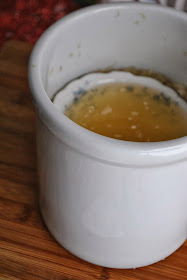

Since NY State is one of the largest suppliers of cabbage, I thought it was only fitting that I post about sauer kraut. I have been wanting to make my own sauer kraut for so long. Why didnt I?
One reason was that I was afraid my house would be filled with stinky cabbage.
Two, I thought it is too scary, I might give my family botulism.
Three, procrastination.
Finally, I overcame my hesitation and made it. It wasn't the least bit stinky. Keep that cabbage covered in its juices and there will be no botulism. The part about procrastination, I just got over that.
In the end you will be rewarded with sauer kraut and its juices. So good for you. It will aid in digestion. Thats the big thing right now, fermented stuff, isnt it?
You might have seen on some blogs that doing them in mason jars is easy. I tell you that I did not find it the least bit easy. I initially placed the cabbage in mason jars. I did let the gas out periodically but what I found is that the brine was pushing out of the jars on its own. I lost a lot of necessary juice.
It was also really hard to weight it or push it down in mason jars. I eventually transferred all but half to a crock. The other half was not under the brine for a couple days. It just wasn't worth risking it. I used that jar as a wait for the remainder of the time.
So my advice to you is to do it in a crock. So much easier!
Sauerkraut
My version printable found here.
Making sauerkraut takes 1 to four weeks.
Initially when I was waiting for the salt to pull the water out of the cabbage I put it all in my Crockpot. It was perfect for the job initially. I flipped the crock lid upside down and put a weight on it. I used my flour canister.
Equipment Needed
crock
a plate or something that is non reactive that you can place weights on for the top of the sauerkraut
a weight to keep the plate submerged
5 pounds cabbage
3 tablespoons sea salt
-Chop or grate cabbage, finely or coarsely. Sprinkle salt on the cabbage, tossing it in. The salt pulls water out of the cabbage and this creates the brine in which the cabbage can ferment and sour without rotting.
-Mix ingredients together and pack into crock. Pack just a bit into the crock at a time and tamp it down hard using your fists. This pressure packs the kraut tight and helps force water out of the cabbage.
-Cover the cabbage with a plate or some other lid that fits snugly inside the crock. Place a clean weight on the cover. This weight is to force water out of the cabbage and then keep the cabbage submerged under the brine. This can take up to about 24 hours.
-Leave in a cool place to ferment or you can keep it in the kitchen (away from heat sources or sunny windows).
Links to information on making sauer kraut:
Wild Fermentation
The Kitchn: Making Sauerkraut





No comments:
Post a Comment
Thanks for visiting my site. I enjoy hearing all of your comments.